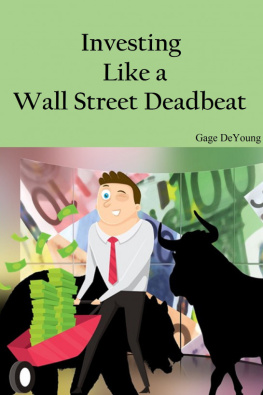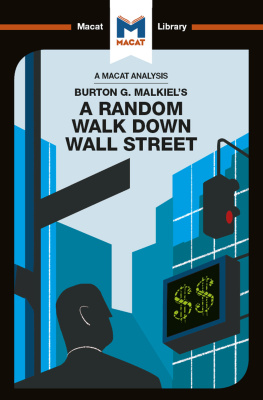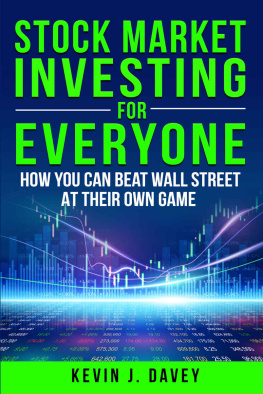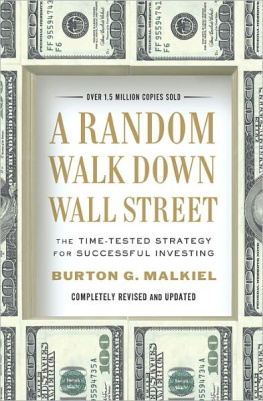
A RANDOM WALK
DOWN WALL STREET

The Time-Tested Strategy for
Successful Investing

BURTON G. MALKIEL

W. W. NORTON & COMPANY
Independent Publishers Since 1923
New York London
Copyright 2019, 2016, 2015, 2012, 2011, 2007, 2003, 1999, 1996, 1990, 1985, 1981, 1975, 1973 by W. W. Norton & Company, Inc.
The article on page 308 entitled Red Faces in Park appears courtesy of Thomson Reuters. All rights reserved. Republication or redistribution of Thomson Reuters content, including by framing or similar means, is expressly prohibited without the prior written consent of Thomson Reuters. Thomson Reuters and its logo are registered trademarks or trademarks of the Thomson Reuters group of companies around the world. Thomson Reuters 2009. Thomson Reuters journalists are subject to an Editorial Handbook, which requires fair presentation and disclosure of relevant interests.
All rights reserved
For information about permission to reproduce selections from this book,
write to Permissions, W. W. Norton & Company, Inc.,
500 Fifth Avenue, New York, NY 10110
For information about special discounts for bulk purchases, please contact
W. W. Norton Special Sales at specialsales@wwnorton.com or 800-233-4830
JACKET DESIGN BY PETE GARCEAU
JACKET PHOTOGRAPH THINKSTOCK/GETTYI MAGES
Book design by Chris Welch
Production manager: Anna Oler
The Library of Congress has cataloged the printed edition as follows:
Names: Malkiel, Burton Gordon, author.
Title: A random walk down Wall Street : the time-tested strategy
for successful investing / Burton G. Malkiel.
Description: New York : W.W. Norton & Company, [2019] | Includes index.
Identifiers: LCCN 2018042154 | ISBN 9781324002185 (hardcover)
Subjects: LCSH: Investments. | Stocks. | Random walks (Mathematics)
Classification: LCC HG4521 .M284 2019 | DDC 332.63/2042dc23
LC record available at https://lccn.loc.gov/2018042154
ISBN: 978-0-39335-693-9 (ebk.)
W. W. Norton & Company, Inc., 500 Fifth Avenue, New York, N.Y. 10110
www.wwnorton.com
W. W. Norton & Company Ltd., 15 Carlisle Street, London W1D 3BS
FOR NANCY AND PIPER

CONTENTS
Part One
STOCKS AND THEIR VALUE
Part Two
HOW THE PROS PLAY THE BIGGEST GAME IN TOWN
Part Three
THE NEW INVESTMENT TECHNOLOGY
Part Four
A PRACTICAL GUIDE FOR RANDOM WALKERS AND OTHER INVESTORS
IT HAS NOW been over forty-five years since the first edition of A Random Walk Down Wall Street. The message of the original edition was a very simple one: Investors would be far better off buying and holding an index fund than attempting to buy and sell individual securities or actively managed mutual funds. I boldly stated that buying and holding all the stocks in a broad stock-market average was likely to outperform professionally managed funds whose high expense charges and large trading costs detract substantially from investment returns.
Now, over forty-five years later, I believe even more strongly in that original thesis, and theres more than a six-figure gain to prove it. I can make the case with great simplicity. An investor with $10,000 at the start of 1969 who invested in a Standard & Poors 500-Stock Index Fund would have had a portfolio worth $1,092,489 by April 2018, assuming that all dividends were reinvested. A second investor who instead purchased shares in the average actively managed fund would have seen his investment grow to $817,741. The difference is dramatic. Through April 1, 2018, the index investor was ahead by $274,748, an amount over 25 percent greater than the final stake of the average investor in a managed fund.
Why, then, a twelfth edition of this book? If the basic message hasnt changed, what has? The answer is that there have been enormous changes in the financial instruments available to the public. A book meant to provide a comprehensive investment guide for individual investors needs to be updated to cover the full range of investment products available. In addition, investors can benefit from a critical analysis of the wealth of new information provided by academic researchers and market professionalsmade comprehensible in prose accessible to everyone with an interest in investing. There have been so many bewildering claims about the stock market that its important to have a book that sets the record straight.
Over the past forty-five years, we have become accustomed to accepting the rapid pace of technological change in our physical environment. Innovations such as e-mail, the Internet, smartphones, personal digital assistants, smart home devices, iPads, Kindles, videoconferencing, social networks, and new medical advances ranging from organ transplants and laser surgery to nonsurgical methods of treating kidney stones and unclogging arteries have materially affected the way we live. Financial innovation over the same period has been equally rapid. In 1973, we did not have money-market funds, ATMs, index mutual funds, ETFs, tax-exempt funds, emerging-market funds, target-date funds, floating-rate notes, volatility derivatives, inflation protection securities, equity REITs, asset-backed securities, smart beta strategies, Roth IRAs, 529 college savings plans, zero-coupon bonds, financial and commodity futures and options, and new trading techniques such as portfolio insurance and high-frequency trading, to mention just a few of the changes that have occurred in the financial environment. Much of the new material in this book has been included to explain these financial innovations and to show how you as a consumer can benefit from them.
This twelfth edition also provides a clear and easily accessible asks whether smart beta investment strategies are really smart and whether risk parity strategies are too risky. A new section has been added to present practical investment strategies for investors who have retired. So much new material has been added that readers who may have read an earlier edition of this book in college or business school will find this new edition rewarding reading.
This edition takes a hard look at the basic thesis of earlier editions of Random Walkthat the market prices stocks so efficiently that a blindfolded chimpanzee throwing darts at the stock listings can select a portfolio that performs as well as those managed by the experts. Through the past forty-five years, that thesis has held up remarkably well. More than two-thirds of professional portfolio managers have been outperformed by unmanaged broad-based index funds. Nevertheless, there are still both academics and practitioners who doubt the validity of the theory. And the stock-market crash of October 1987, the Internet bubble, and the financial crisis of 200809 raised further questions concerning the vaunted efficiency of the market. This edition explains the recent controversy and reexamines the claim that its possible to beat the market. I conclude that reports of the death of the efficient-market hypothesis are vastly exaggerated. I will, however, review the evidence on a number of techniques of stock selection that are believed to tilt the odds of success in favor of the individual investor.
Next page








